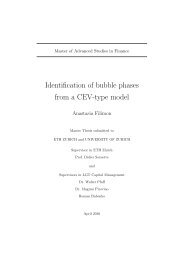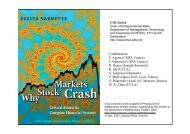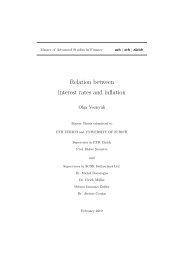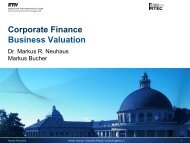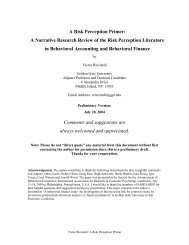Tail Dependence - ETH - Entrepreneurial Risks - ETH Zürich
Tail Dependence - ETH - Entrepreneurial Risks - ETH Zürich
Tail Dependence - ETH - Entrepreneurial Risks - ETH Zürich
Create successful ePaper yourself
Turn your PDF publications into a flip-book with our unique Google optimized e-Paper software.
and finally I obtained:<br />
y(r) =<br />
� � 1<br />
α 1<br />
, (3.50)<br />
1 − r<br />
which allowed me to transform our uniformly distributed data into data distributed<br />
according to relation (3.48) with α = 3.<br />
Putting now the transformed values into equation (3.47) to calculate Hill’s estimator,<br />
I could test whether the output was a tail index ˆν close enough to three representing<br />
the true value α of the tail index for our transformed data.<br />
Conducting this procedure several times allowed me to check whether the standard<br />
deviation fulfills the above described relation of:<br />
std(ˆν)<br />
α ∼ = 1<br />
√ k , (3.51)<br />
which, given α = 3 and n = 100, says that std(ˆν) ∼ = 0.3 and therefore all ˆν should be<br />
within an interval of 3 ±2∗0.3 if the error follows a Gaussian distribution as requested.<br />
I performed the above described sampling 10’000 times and received a mean value of<br />
mean(ˆν) = 3.06, which shows a small bias of 2%, and a 95% deviation-quantile of 0.63,<br />
which is close to the above calculated 0.6. Therefore I conclude that our smaller sample<br />
size with about 100 return data points perceived as tail data already agrees well with<br />
the general assumption of Hill’s estimator to be asymptotically normally distributed.<br />
However, performing this little affirmation we stressed the assumption of using independent<br />
and identically distributed (i.i.d.) data samples, which unfortunately is not<br />
the case for real financial data. Applying Engle’s test for the presence of ARCH effects<br />
[17] (1982) to our real financial time series the result shows significant evidence in<br />
support of GARCH effects (heteroscedasticity) 4 . As shown by Kearns and Pagan [22]<br />
(1997) for heteroskedastic time series the variance of the estimated tail index can be<br />
seven times larger than the variance given by the asymptotic normality assumption.<br />
For comparison I also implemented the OLS (ordinary least squares) log-log rank-size<br />
tail index estimate proposed by Gabaix [23] (2006) defined by:<br />
log(Rank − 1/2) = a − ˆb γ n · log(Size), (3.52)<br />
with the tail index given by ˆb γ n . A standard error of the OLS estimate ˆb γ � n of the slope<br />
2<br />
was estimated to n ˆb γ n in the paper. Assuming a tail index equal to three as above,<br />
this yields a standard error of 0.42, which is higher compared to Hill’s estimator.<br />
We can now perform the same little check as above to see how Gabaix’s ˆb γ n estimator<br />
performs for i.i.d. data samples. Sampling 10’000 times, I obtained a mean value of<br />
mean( ˆb γ n) = 3.015, which only constitutes 0.5% bias and a 95% deviation-quantile of<br />
0.83. This perfectly agrees with the estimated standard error given in the paper [23]<br />
(2006) but still is a little higher than the standard deviation of Hill’s estimator.<br />
Now we can apply both, Hill’s estimator ˆν and Gabaix’s ˆb γ n estimator, on real data<br />
for comparison and subsequently perform bootstrap sampling with replacement (Monte<br />
Carlo simulation) to find out, whether the fact, that real financial time series exhibit<br />
internal dependence, in terms of time varying volatility clustering (large price changes<br />
come in clusters), impact deviation quantiles or in other words: whether Hill’s estimator<br />
4 Engle’s ARCH test is described in subsection (3.2.3)<br />
24



